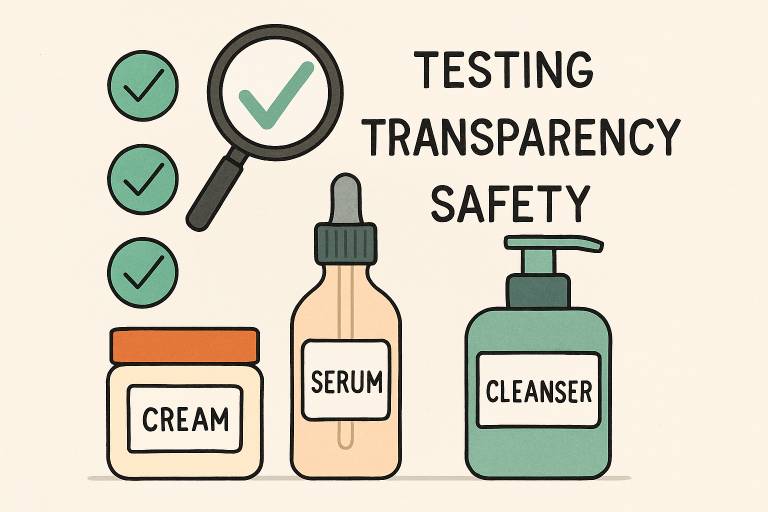Key Takeaways
- Consumers increasingly seek transparency in how beauty products are tested and evaluated.
- Robust product testing ensures both safety and performance claims can be trusted.
- Advancements in ingredient research and testing methods are reshaping the industry.
- Understanding the science behind product testing helps buyers make informed choices.
- Independent and third-party testing play key roles in consumer trust.
- Ethical testing practices, including alternatives to animal testing, are gaining traction worldwide.
A New Era of Transparency in Beauty Product Testing
Modern beauty enthusiasts are no longer satisfied with buzzwords or glossy branding. They crave genuinely transparent information about their favorite products’ safety, effectiveness, and origins. The growth of beauty product testing panels has made a significant impact, giving consumers a window into real-world testing, unbiased product feedback, and clear evidence that backs up marketing claims. With more shoppers expecting openness, brands that share their testing practices and results rapidly earn consumer trust.
A commitment to transparency paves the way for a safer, more ethical beauty landscape. Customers today actively research brands and demand clear explanations about ingredient sourcing, product efficacy, and the processes that ensure their chosen cosmetics are both safe and high-performing. As a result, the importance of robust and reliable testing methods has never been higher.
The Science That Backs Your Favorite Products
Scientific rigor underpins trustworthy beauty claims. There are comprehensive evaluation processes behind every “gentle on skin” promise or “24-hour hydration” claim. Methods such as patch testing assess allergy potential, while advanced clinical studies use data from diverse populations to confirm product benefits.
Developments in ingredient research mean products can be highly effective and less likely to trigger unwanted reactions. Robust scientific validation is transforming the industry for both brands and buyers, whether through benchmarking against established standards or leveraging innovations in skin biology.
Common Testing Methods in the Cosmetics Industry
- Patch Testing: Checks new formulas on small skin sections to monitor for irritation or allergic response, ensuring compatibility across skin types.
- Stability Testing: Monitors how products respond to time, heat, light, and air, confirming they maintain quality and efficacy throughout shelf life.
- Clinical Trials: Gathers objective measurements from real people, assessing claims like “reduced redness” or “visible firming.” These trials provide critical evidence used in marketing and regulatory approval.
- Microbial Challenge Tests: Assure that creams, serums, and other personal care items do not cultivate harmful bacteria or fungi, crucial for user safety.
These evaluation methods are often overseen by third-party laboratories, adding further credibility. Rigorous product vetting before launch allows for discovering and mitigating any safety or quality concerns.
Ensuring Safety: What Goes into the Process?
Cosmetic safety is a multi-step commitment. The initial phase is a comprehensive toxicological review of each ingredient to identify potential irritants or hazards. Next, formulas are stress-tested for stability and preservative robustness to ensure the product remains safe and effective under various usage and storage conditions.
Human trials form the next phase, as products are evaluated for both adverse effects and positive results in controlled settings. This careful ladder of assessments is designed to prevent negative skin reactions and proactively uphold public health standards. For consumers, these steps are a safeguard they ensure that self-care at home aligns with global safety benchmarks.
Product Claims and Validity: Why It Matters
In an era of bold advertising, substantiation of claims is a legal and ethical imperative. Regulators like the U.S. Food and Drug Administration (FDA) and the Federal Trade Commission (FTC) require brands to furnish tangible proof behind every performance or safety claim. Rigorous clinical trials and large-scale consumer panels supply the empirical data supporting on-pack promises, as seen with claims like “reduces blemishes in 2 weeks” or “minimizes the appearance of pores.”
Accountable marketing protects the buyer from misinformation and exaggeration. By referencing verifiable data, brands signal credibility helping consumers place trust in accurate, science-backed cosmetic solutions.
Ethical Considerations: From Animal Alternatives to Eco-Friendly Testing
Rising ethical standards are changing the landscape of test methodologies. With mounting consumer concern around animal welfare, brands are switching to alternatives like in vitro laboratory studies and advanced computer modeling.
In addition, eco-aware testing strategies ranging from using recycled lab materials to environmentally sensitive waste management are now integrated into R&D pipelines. Certifications like cruelty-free or vegan are highly sought by informed shoppers who value sustainability and efficacy. These trends underscore the industry’s move toward holistic responsibility, where human and planetary health are paramount.
Innovation and the Future of Beauty Testing
Technology is accelerating the pace of cosmetic safety. Artificial intelligence, machine learning, and digital biosensors are harnessed to assess ingredient profiles, predict outcomes, and detect sensitivities much more efficiently than traditional trials. AI-driven models can evaluate complex ingredient interactions or simulate possible reactions, minimizing the need for lengthy or invasive studies. According to Scientific American, such tools are already reshaping safety protocols in product development, allowing companies to bring better products to market faster.
Additionally, these innovative practices help foster greater inclusivity by ensuring that safety and efficacy claims address the needs of diverse communities. The net result is a safer, more informed, and more ethical industry.
How Consumers Can Interpret Testing Results
Understanding testing results empowers consumers to make truly informed choices. Labels such as “dermatologist-tested,” “non-comedogenic,” or “hypoallergenic” signal specific safety credentials, but smart buyers should also look for third-party certifications and independent reviews. Transparency around lab methods, consumer panel data, and study design offers another layer of reassurance.
Before buying, check for published research, ingredient transparency, and independent lab validation. Publications like Consumer Reports offer valuable guides to deciphering claims, helping you decode packaging jargon and focus on what matters for your skin health and values.

